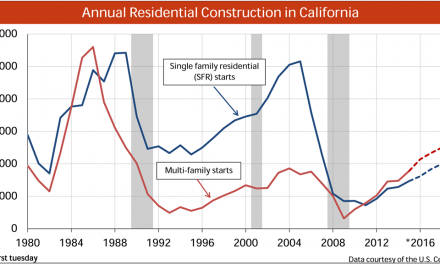Added Calif. Health and Safety Code §§50610-50613
Effective date: January 1, 2024
Bill text: SB 555
Identifying the immediate needs for California housing
While California more than doubled its production of units for California’s economically vulnerable residents since 2019, available public funding provided just 12% of the total units needed to meet the state’s goals for low income homes, according to a 2024 report by California Housing Partnership (CHPC).
This supply and demand crisis has resulted in over half of the state’s renter households being rent-burdened — paying greater than 30% of their income towards housing costs. The rent burden is even more debilitating for low income earners who forfeit 80% of their income to housing, according to the Bill’s Analysis.
The private housing market has failed to meet the housing needs of most Californians at low income and moderate income levels. Together, California residents at these income levels account for 58% of the overall population in need of housing, per the Bill’s Text.
In 2024, the average asking rent is $2,950, according to data from Redfin. At this amount, a minimum wage worker needs 2.8 full time jobs to qualify to pay rent, according to the CHP Report. This disparity is the result of rents rising faster than incomes, compounded by the supply and demand imbalance.
Related article:
Moreover, residential construction has not caught up. In 2023, roughly 110,000 new residential housing units were started across the state — better than no construction, but equal to just 12% of the low income housing shortfall according to the 2024 CHP Report and U.S. Census Data.
Related Article:
When considering only a fraction of these units are suitable for low income households, the number of homes still needed to house the low income population grows.
Only 50% of California’s households qualify to pay the cost of housing in their local market. As a result, virtually none of California’s low income and very low income households qualify for the cost of housing on their own, according to the McKinsey Global Institute.
The result of the inability for low income or very low income households to qualify for housing of their own is:
- reduced household formation; and
- less money available for each household to spend on goods and services in the local economy.
California needs 3.5 million new housing units by 2025 to overcome its housing shortage, according to an analysis in the McKinsey report.
Related Article:
For real estate professionals, the low income rental crisis spills over to all segments of the housing market. Tenants spending more than half of their income on rent have no income available to set aside in savings – the precursor to ownership. Most the state’s low income renters will never be able to become homeowners, since they are unable to:
- save up for down payments; or
- improve their financial situations.
Thus, it is unsurprising six of the nation’s top ten least inclusionary homebuying markets are in California, according to Zillow.
While federal efforts such as the Low-Income Housing Tax Credits (LIHTC) program aim to address the growing need, they are woefully insufficient to meet the need for housing accessible to economically venerable residents who are not able to qualify at market rates.
Related Articles:
Lack of affordable rental housing is becoming an emergency in California
Stable Affordable Housing Act of 2023
In response to this crisis, the state of California passed the Stable Affordable Housing Act of 2023. [Calif. Health and Safety Code §50610]
The Act attempts to address the growing supply and demand imbalance plaguing California’s economically vulnerable residents.
Explicitly, the state’s goal is to create 2.5 million new housing units by 2031. Of these 2.5 million new units, at least 1.1 million need to be inclusionary for households with:
- low income;
- very low income; and
- extremely low levels of income.
Further, 400,000 of the remaining 1.4 million units need to be accessible to households with moderate incomes. [Calif. Health and Safety Code §50611(a)(2)].
Beginning January 1, 2024, the Department of Housing and Community Development (HCD) needs to annually report an analysis of housing needs for the various income levels identified in the sixth Regional Housing Needs Assessment (RHNA). The HCD specifically focuses on below-market rate housing which is inclusionary for households with:
- moderate income (an income of 80% to 120% of the local area median income (AMI));
- low income (an income of 50% to 80% of the AMI ;
- very low income (an income of 30% to 50% of the AMI; and
- extremely low levels of income (an income less than 30% of the AMI, according to the Statewide Housing Plan (SHP)). [Health & S C §50613(a)]
Editor’s note – The Department of Finance (DOF) and HCD prepares the RHNA to estimate the needs of very low income, low income, moderate income and above moderate income levels. Councils of government or the HCD allocate housing within each region based on these estimates, and cities and counties plan for these accommodations in their housing elements. The RHNA restarts every eight years. The sixth RHNA cycle started in 2023.
Related Article:
New California law incentivizes local governments to create mid-tier housing
To address the crisis, the Act seeks to scale up California’s growing social housing sector, as discussed below.
According to the Bill’s Analysis, to meet the housing need for low income and moderate income levels, the expansion of California’s social housing sector requires a robust partnership between the state and federal government. [Health & S C §50611(a)(4)]
The partnership requires not only a significant infusion of federal funding, but also policy reforms at both the state and federal levels. To accomplish this, the HCD will evaluate potential future legislation for creating below market-rate housing, which includes both housing options for economically venerable Californians and social housing options. [Health & S C §§50611(a)(4), (b)]
Related Article:
What is “social housing”?
Social housing units are units which accommodate a mix of household income ranges unable to qualify at today’s market rents. The owner and manager of social housing units is either a:
- public agency;
- local authority;
- limited-equity housing cooperative; or
- mission-driven nonprofit entity. [Health & S C §§50612(j)(1), (2)]
A social housing development includes both:
- newly constructed units; and
- existing units preserved or rehabilitated as social housing. [Health & S C §50612(k)]
Residents within social housing units also enjoy:
- full protection against unlawful terminations; and
- due process in eviction procedures. [Health & S C §50612(j)(3)]
Likewise, residents have the right to directly participate in decisions affecting the operation and management of their units. [Health & S C §§50612(j)(5)]
Significantly, social housing units are protected for the duration of their useful life, while the land associated with the housing is permanently protected from being sold or transferred to any:
- person;
- for-profit entity; or
- a public-private partnership. [Health & S C §50612(j)(4)]
Related Article:
California Social Housing Study
The Act requires the HCD to complete a California Social Housing Study by December 2026, to assist low income and moderate income households access below market-rate housing.
The study is a comprehensive analysis into:
- the creation of inclusionary housing for California’s economically vulnerable residents; and
- social housing at the scale needed to address the housing crisis.
To complete their comprehensive analysis, the HCD will enlist:
- residents unable to qualify for market-rate rents;
- public agencies; and
- mission-driven nonprofit entities. [Health & S C §50613(a)]
The study produced by the HCD analyzes:
- state and federal funding available for housing;
- public lands; and
- other resources available to increase homeownership for all income levels.
Related Articles:
Everything a California real estate agent needs to know about public lands
Unused commercial space continues to convert into much-needed apartments
Simultaneously, the HCD also analyzes constraints and obstacles to achieving the state’s goals, including:
- capital financing; and
- long-term operations and maintenance needs. [Health & S C §§50613(a)(1)(A), (C), (G)]
Further, the HCD analyzes the impact these social housing policies will have on job creation and local economies when locally based, union-represented workforces are employed for the construction and maintenance of these projects. [Health & S C §50613(a)(1)(F)]
From the data collected in the analysis, the HCD further makes recommendations to:
- use funding, public land and other resources to create housing for low income and moderate income households;
- remove constraints on the use of public land and public funding which do not require legislative action; and
- make additional resources available, including a social housing [Health & S C §50613(a)(2)]
Related Articles:
Dept of Housing and Community Development flexes new enforcement powers
New law adds muscle to Attorney General’s Housing Strike Force
Build up, not out
Suburban sprawl has proven to be a poor long-term housing and retail strategy. The suburban sprawl trend leads to higher construction costs and less desirable outcomes for homeowners, as the lack of inclusionary housing forces households into neighborhoods with fewer amenities and longer commutes.
Prompt action on the re-zoning of city center parcels will take advantage of vertical environment — build up, not out.
Re-zoning will level out the next home price boom from turning into another market-killing pricing bubble. A boom is expected after 2026, when rising prices of existing single family residence (SFR) housing will stabilize as new units are built.
Related Article:
An evaluation of streamlined housing production under SB 35 after five years
Combatting NIMBYism
Due to declining state and local funding, production of inclusionary housing has dropped by almost 9,000 units (38%) in the last year according to the 2024 CHP report
Not-in-my-backyard (NIMBY) advocates have wagged their fingers and pounded their fists at low income housing construction, certain it will diminish nearby home values – but it is simply not true.
Related Article:
Attorney General files lawsuit against Elk Grove for violating state housing laws
In fact, low income housing has a pulse which contributes to property values in their communities. Low income housing developments increase moderate and above moderate-tier home values by 4% within half a mile of the new low income housing development, according to a study published by Cityscape.
The inclusion of low income housing provides a variety of benefits, including:
- more site selection in neighborhoods already experiencing an upward price trend due to their desirable location – the appreciation factor;
- increased population density in the community; and
- the replacement of deteriorating or vacant property.
The increase of value to neighboring homes debunks the bigoted NIMBY notion that low income housing is ruining communities by “forcing” higher-income families out of the area.
However, California workers currently suffer from long commutes to work. A lack of inclusionary housing options near job centers forces low income and moderate income workers to live far from work, leading to longer commutes, according to a 2022 UCLA study.
As a result, the average one-way commute for California workers is:
- 35 minutes in San Francisco;
- 34 minutes in Riverside;
- 32 minutes in Los Angeles;
- 30 minutes in San Jose;
- 28 minutes in Sacramento; and
- 27 minutes in San Diego, according to a 2019 Census report.
This trend is deleterious since research suggests long commutes have serious negative health effects. Just a 10-mile one-way commute is associated with a greater risk of heart disease, according to the American Journal of Preventive Medicine.
Moving out of cities due to unsustainably high housing costs also limits the economic mobility of workers. Low income workers who live near job centers are more likely to experience upward mobility according to a Department of Housing and Urban Development study.
The impacts of long commutes are even more concerning for real estate professionals, who spend a significant amount of time driving as part of their work.
Real estate agents — put those NIMBY myths to rest.
Pushing for more variation in housing types opens the door not only to future transactions in your neighborhood, but clearly generates opportunities to invest in these developments.
Related Articles:
One more barrier to low-income housing in California: Article 34



















